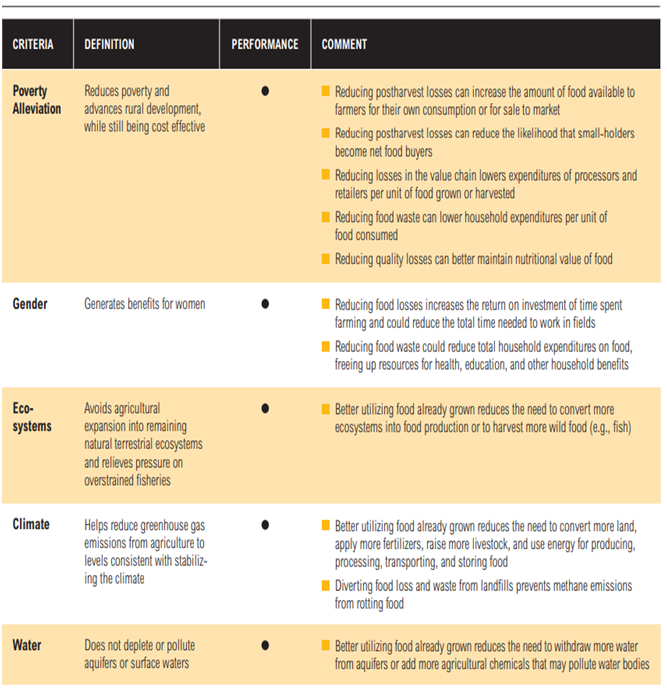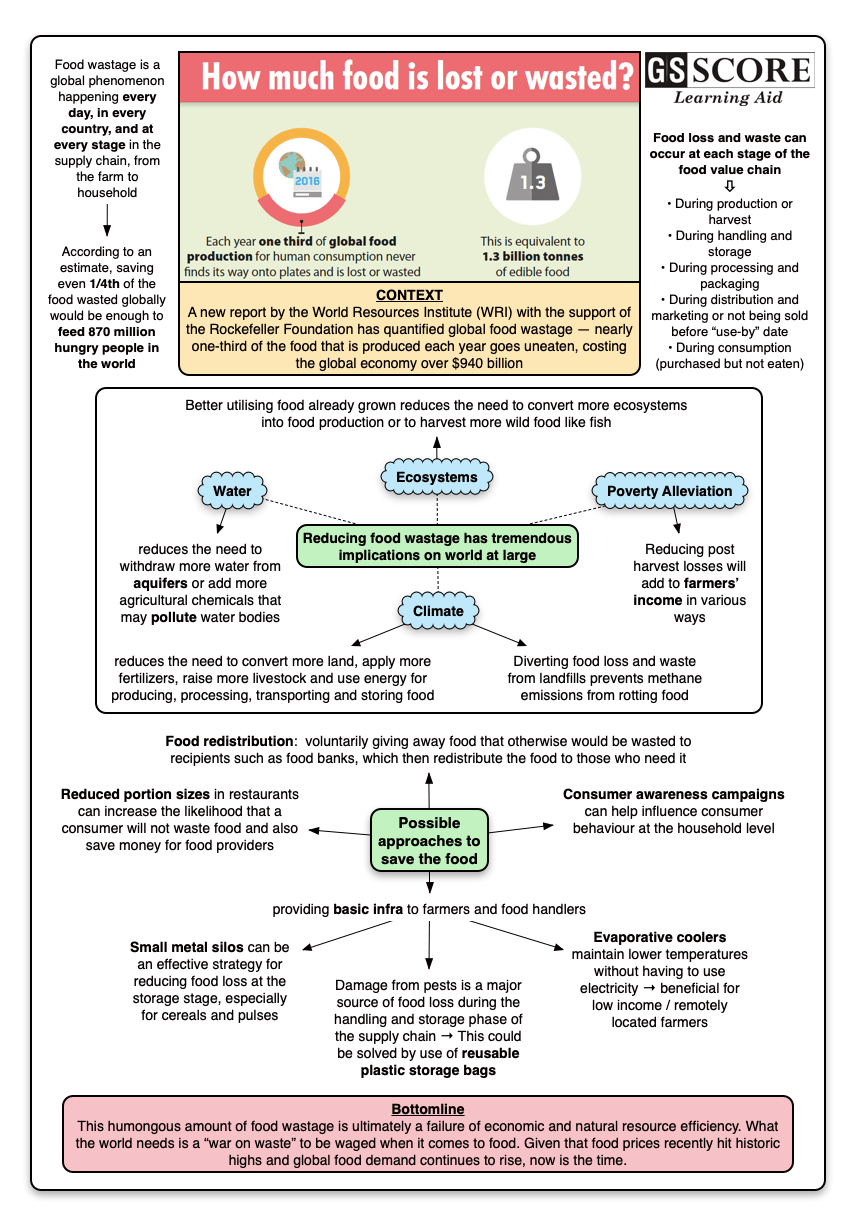

A new report by the World Resources Institute (WRI) with the support of the Rockefeller Foundation has quantified global food wastage — nearly one-third of the food that is produced each year goes uneaten, costing the global economy over $940 billion.
Issue
Context
A new report by the World Resources Institute (WRI) with the support of the Rockefeller Foundation has quantified global food wastage — nearly one-third of the food that is produced each year goes uneaten, costing the global economy over $940 billion.
Background
- Significant amounts of food are lost or wasted every day, in every country, and at every stage in the supply chain, from the farm to household.
- According to an estimate by the Food and Agriculture Organization of the United Nations (FAO), about one-third of food produced is lost or wasted globally, which is approximately 1.3 billion tones.
- One out of every four food calories intended for people is not ultimately consumed by them.
- Costs aside, food loss has significant impacts on food security, environmental conservation, and climate change.
- It is estimated that saving one-fourth of the food currently lost or wasted globally would be enough to feed 870 million hungry people in the world, of which the highest number are in India.
Meaning
- “Food loss and waste” refers to the edible parts of plants and animals that are produced or harvested for human consumption but that are not ultimately consumed by people.
- “Food loss” refers to food that spills, spoils, incurs an abnormal reduction in quality such as bruising or wilting, or otherwise gets lost before it reaches the consumer.
- Food loss is the unintended result of an agricultural process or technical limitation in storage, infrastructure, packaging, or marketing.
- “Food waste” refers to food that is of good quality and fit for human consumption but that does not get consumed because it is discarded—either before or after it spoils. Food waste is the result of negligence or a conscious decision to throw food away.
How “Reducing Food Loss and Waste” Performs Against the Sustainable Food Future Criteria

Food loss and waste can occur at each stage of the food value chain
- During production or harvest in the form of grain left behind by poor harvesting equipment, discarded fish, and fruit not harvested or discarded because they fail to meet quality standards or are uneconomical to harvest.
- During handling and storage in the form of food degraded by pests, fungus, and disease.
- During processing and packaging in the form of spilled milk, damaged fish, and fruit unsuitable for processing. Processed foods may be lost or wasted because of poor order forecasting and inefficient factory processes.
- During distribution and marketing in the form of edible food discarded because it is non-compliant with aesthetic quality standards or is not sold before “best before” and “use-by” dates.
- During consumption in the form of food purchased by consumers, restaurants, and caterers but not eaten.
Possible Approaches to save the food
- Food redistribution: Food redistribution or donation programs are a method for reducing both food loss and waste. As used here, “food redistribution” means voluntarily giving away food that otherwise would be lost or wasted to recipients such as food banks, which then redistribute the food to those who need it.
- Evaporative coolers: Evaporative coolers extend the shelf life of food and avoid spoilage by keeping food at lower-than-room temperatures without having to use electricity. This lowcost, low-energy technique provides an opportunity to store perishable foods longer in areas that lack electricity infrastructure or that has low-income farmers.
- Plastic storage bags: Damage from pests is a major source of food loss during the handling and storage phase of the supply chain. Take cowpeas for instance. The crop is important for many smallholder farmers due to the cowpeas’ ability to adapt to dry, hot conditions.
- Small metal silos: Small metal silos, which are intended for use by one farmer or by one household and generally hold between 250–1000 kg of crops, can be an effective strategy for reducing food loss at the storage stage, especially for cereals and pulses. Insufficient storage is a major source of food loss for farmers, especially in developing countries, where storage structures often do not keep harvested crops in hermetic or airtight conditions.
- Plastic crates: Using plastic crates instead of other forms of containerization has demonstrated significant reductions in food losses during handling and storage, particularly among fruits, vegetables, and other forms of fresh produce. In developing countries, 19 percent of fruit and vegetable loss occurs in the handling and storage stage of the food value chain.
- Food date labeling: Dates provided on the packaging of food and drinks, such as “use-by,”“sell-by,” and “best before,” is intended to provide consumers with information regarding the freshness and safety of foods. However, these seemingly simple dates can actually confuse consumers about how long it is safe for them to store food and when they should dispose of uneaten items.
- Consumer awareness campaigns: Consumer attitudes and behavior play a large role in determining the amount of food that is wasted in households. Although changing the way people consume and throw out food can be difficult, communication campaigns can help influence consumer behavior at the household level.
- Reduced portion sizes: For restaurants and other food service providers, food portion sizes can dictate the amount of food waste that occurs within the four walls of their business, since larger portions increase the likelihood that a consumer will not consume all of the food purchased. Reducing portion sizes for consumers in both direct and indirect ways can both decrease food waste and save money for food providers.
Conclusion
- An amazing 24 percent of all food calories grown today are lost or wasted between the farm and the fork.
- This fact is ultimately a failure of economic and natural resource efficiency. The world faced an analogous failure of efficiency in the 1970s with energy.
- In the face of record oil prices and growing demand, the world essentially declared war on energy wastefulness and significantly improved its energy efficiency.
- Yet a “war on waste” has yet to be waged when it comes to food. Given that food prices recently hit historic highs and global food demand continues to rise, now is the time.
Learning Aid



